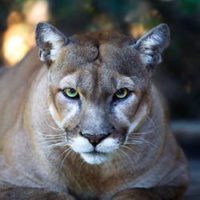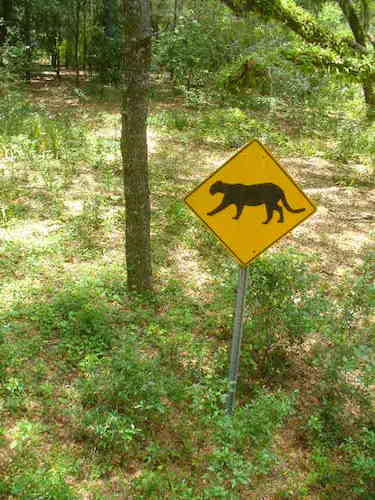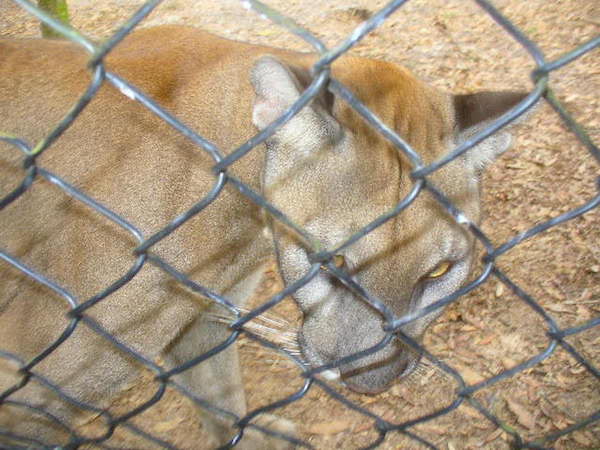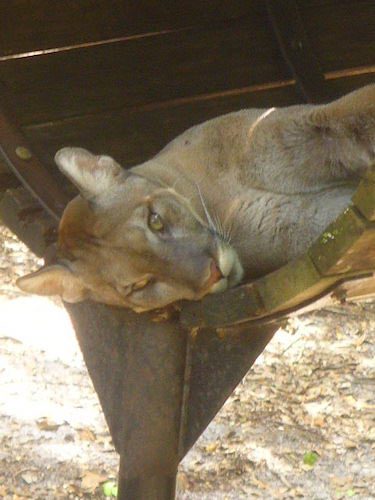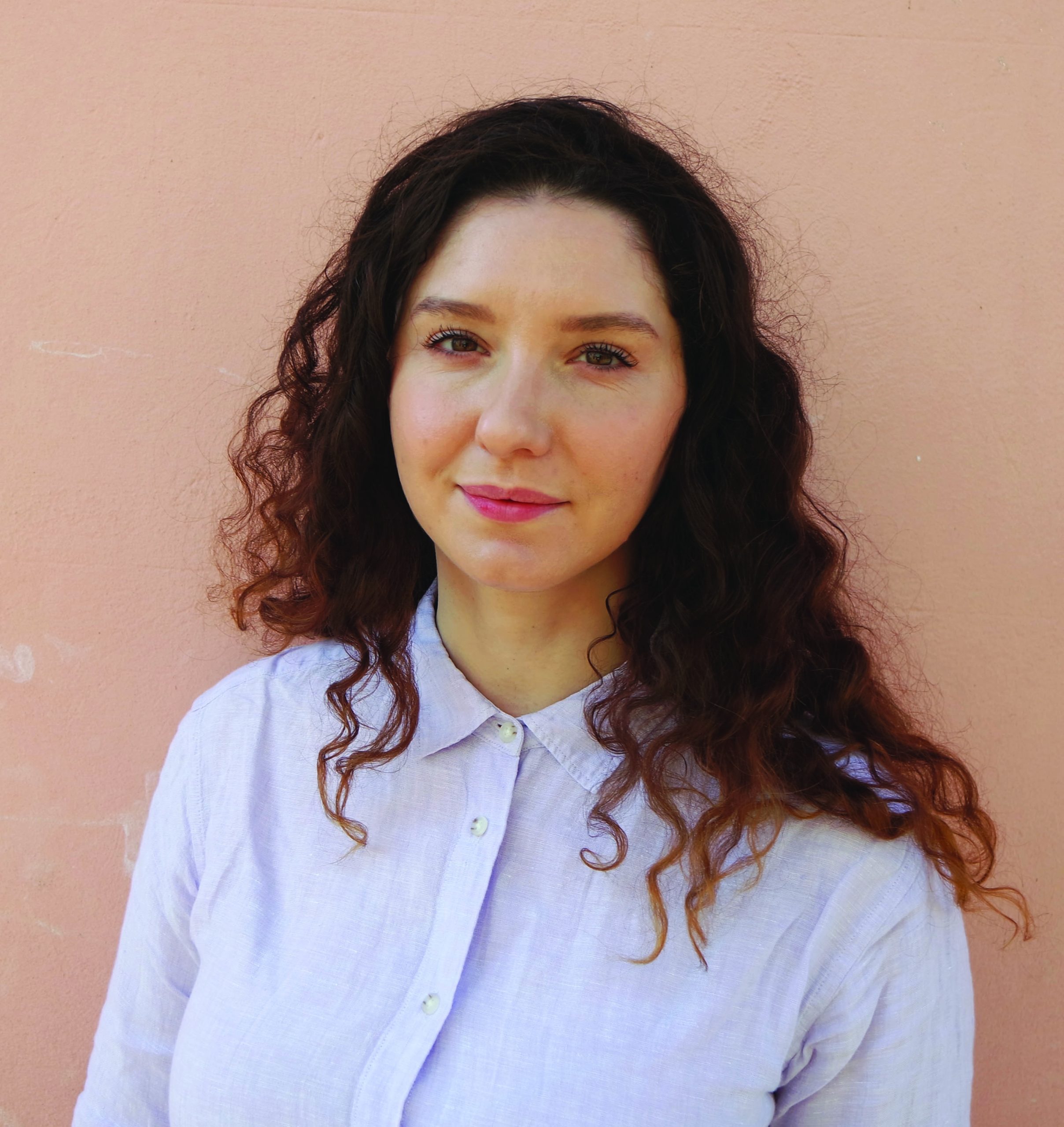Not long ago, the largest cat in Eastern America, the Florida panther, was categorized as “wildlife of unknown status” by ecologists, a label given to ivory-billed woodpeckers, Bigfoot, and the Loch Ness monster. Until the 1980s, the Florida panther was presumed extinct or myth, reported by weary commuters and conspiracy theorists. Tracking one, when scientists realized they existed, required groups of men and dogs reading paw prints, following scent, riding in handmade amphibious jeeps, traversing cottonmouth-filled swamps, and then finally treeing a panther for days.
And the cats could jump tree-to-tree.
Even now, how do you study an animal that hunts and wanders in the cobalt of twilight? Panthers swim in the jungle, stalk by stealth. They do not bask in savannas like their African cousins, lazily observed by khaki-clad safarists. They are hunted by search light, satellites, and GPS—nervous scientists knee-deep in the Everglades.
There are only 100 to 200 Florida panthers left in the world, a numerical range that reflects their elusiveness as much as their rarity.
Recently, I had the chance to see two very different sides of the Florida panther. The Tallahassee Museum was not, as one might think, a concrete and taxidermy repository. It was a wildlife preserve, zoo theme park, and environmental education center rolled into one, a colorful, sensory overloading hybrid in Florida’s capital city.
The museum was almost entirely open air, and the wildlife pens have dirt floors bordered with cypress trees and wood walkways. There was a ropes course for kids and zip lines for the adrenaline-seeking. Teenagers patrolled the grounds wearing avocado green T-shirts, holstered walkie talkies, and Gary-Cooper-in-High-Noon scowls. The museum’s animals were almost entirely native—endangered gopher tortoises, alligators, bobcats, red wolves, black bears. Clip art of the Florida panther floated above maps at every turn.
In 1985, the first Florida panther was captured live by scientists with a drugged deer carcass, confirming its existence. Before, the most recent Florida panther count had been in 1935 when scientists “collected” eight panthers, field work in those days requiring shotguns.
The day I encountered one, I met a different breed of scientist. The panther handler, Mike Jones, and I shook hands on a log bridge, under which swam squabbling otters. His voice vibrated the same baritone as when he agreed to meet over the phone, a syrupy Southern, unhurried octave. He was unexpectedly refrigerator-sized, covered in sweat, with a foot-long beard and alligator bite handshake.
“Now’s a busy time of year,” Jones said. “But when is it not? We got shipments of sides of beef, cages to clean, otters that are fighting. School kids to lecture. We just put up this ropes course. But it’s nice. While the guests scream and climb trees, I get to play with the big cats.”
Mike opened a door in a bamboo fence marked “DANGER, RESTRICTED.” We huffed across the grassy enclosure and came to another fence made of chain link where Mike raised and closed a guillotine-like pen door. A panther curled in a ball on the sand on the other side rose, sniffed, and charged, full-gait, across the grass toward us.
“Here Buddha, Buddha, Buddha,” Mike yelled, letting the guillotine door drop.
I’d never faced a panther up close, much less charging. I expected something from National Geographic—a tornado of fur, claws, hissing, fangs. But Buddha slowed, and his body slid against the fence, jaw hanging, a face molded into a dejected puppy look of pitifulness. The mouth widened and yowled, a hitch-pitched, rusty door-hinge squeak.
“There’s Booty-boo, booty-boo,” Mike said. “Good Bubba.”
Florida panthers are, despite popular belief, not purple nor blue nor black nor even dark, but a creamy tan color with an egg-white belly. The most visible difference between them and mountain lions is that they’re smaller and, at the end of the Florida cat’s angular belly, there is a fat, boa tail with a periscope kink, a defect, the mark of decades of breeding with cousins.
Puma concolor coryi once resided throughout the South, its range extending from Virginia to East Texas, a proving ground of 436,000 square miles, more than twice the size of California. That land has been diminished by hunting, trapping, urban sprawl, and poisoning to a paw print of land in Florida, two percent of its original home. Florida panthers once commingled with cougars but have since become isolated in a genetic bottleneck, much like the way the American Kennel Association quarantines its breeds.
In the late 1980s, a stereotype developed from the first-caught, not-so ferocious panther female. The bagged cat was inbred, brittle, anemic, pale-faced, and senile. She was old-world royalty, not a jungle monarch. After her, the first radio-collared animals kept dying.
The public seized on Florida’s rare, dying, predator mammals. The media sensationalized the sparse data, and federal and state agencies demanded scientists carry out more experimentation, field monitoring, and cat bagging. When the Endangered Species Preservation Act was signed, the Florida panther was one of the first species listed.
Probably no more has been done for a single cat: thousands of acres bought and set aside for refuge, inoculations for kittens, captive breeding, steep fines for killing and poaching, construction of corridors so the cats can slink under busy roadways, and protocols to reduce metal poisoning. Injured panthers have even been airlifted by helicopter.
In 1995, Floridians initiated a captive breeding program to help alleviate the genetic logjam. Scientists tranquilized and shipped eight Texas female cougars to the swamps of the Big Cypress National Reserve in South Florida, where some of the last few Florida panthers remained. After bearing a litter each, the eight Texas females were tracked, darted, and returned to sender.
Buddha, like all Florida panthers, was smaller than a cougar, but his paws could spread across a basketball. As each paw landed on his side of the cage, it stirred a wave of dust. His ears appeared ruffled, but firm, muscular. The arc of his back like a slim rhinoceros’s. His eyes a penetrating steel blue.
Buddha pressed against the diamond links and tufts of his fur leaked out. He gaped his jaws, and a canine tooth caught on the steel. Buddha stopped and examined the chain link. When he turned, I noticed his twiggy forelegs. This appearance came from the calcium-deficient diet at his previous refuge. Buddha had to make an effort to pick each paw up, otherwise it would drag. He yowled, cried, and even, if my ears were hearing right, purred.
Mike ran a meaty finger through the mesh, rustling the cat’s fur. Then he glanced at me, shrugged. “He’s spoiled rotten, this one.”
Across the pen, a family mingled on the boardwalk that spanned over the panther pen. They yelled down, “What’s that cat’s name?”
Mike peered up, stiffened, but smiled.
“There’s two prevailing theories,” he said to the family, raising a hand from his wide belt. “One,” he counted off, “is to give the animal a name for practical purposes and because it shows we care. The other theory is that a name somehow degrades the cat. That it would make him less animal.”
The crowd nodded their heads and pretended to understand.
“Anyway,” Mike went on, “if we named him, people would be calling down, all day long, and that might irritate him. We want the guy relaxed.”
The family chuckled, nodded, and moved on.
“He has a name,” Mike whispered, and glanced down at Buddha, whose mouth was still open, mewing. “But we use that just between us.”
Later, as I spent an hour gazing down at Buddha from the wooden walkway and family after family passed and yelling down, “Hey kitty, kitty, kitty,” I wondered if perhaps the big cat thought he had another name.
Which would be in keeping with the panther’s history. When the Dutch landed they reported “lions” in Florida. When the Spanish colonized the area they gave the cat the Greek name “panther” for what they thought of as a “leopard.” Some people still today report seeing leopards in Florida. Others cheetahs, pumas, Sasquatch.
And there are over a two dozen subspecies of cougar, each closely related to the Florida panther, spread across the Americas. Scientists in just the last decade, after inspecting numerous DNA chains, discovered that each puma, from Tierra del Fuego to the Arctic Circle, could breed with any other.
And that, taxonomically, made all of the cats, with all these different names, the same.
Florida panther is just one modern variation—one of the twenty-four names for the same creature that presses its jaws against the chain link in front of me, pawing the earth, and begging for a cow leg.
Charles Linnaeus was the first to classify the mountain lions as felis concolor, or cat of one color. Inaccurate because cougars are double-tone—white and tan. The Latin nomenclature later changed to puma concolor. But the name underscores that one of the largest distributed land mammals in the world, occupying mountains, prairies, deserts, swamps, and forests from Argentina to the Yukon, puma concolor is all one animal.
Buddha the panther, Buddha the puma, catamount, mountain lion, mountain cat, cougar, caterwaul. All these names are for the same animal, and in fact, no other species has so many common names for the same thing in one language.
And so, Buddha seems like a perfect name: Gautama Buddha, short for Siddhartha Gautama Buddha, otherwise known as P. Sammasambuddha, S. Samyaksambuddha, or the Awakened One, the Enlightened One, the Peaceful Enlightened One, or the Supreme Buddha or Sage of the Sakya. The cat in Florida is the same cat in all.
But we have not always been so kind to his incarnations. Massachusetts Puritans in the 1600s once offered five shillings per cougar corpse. In Connecticut, you could get twenty shillings. And Jesuit priests in Baja California upped the ante to an entire live adult bull for every mountain lion killed.
This was America when predator eradication was not just an economic but a social good, a nature purification. One early government official wrote, “Large predator mammals, destructive of livestock and game, no longer have a place in our advancing civilization.” Even the Audubon Society was exterminating raptors to spare song birds.
Predator control roundups in Pennsylvania in the 1700s consisted of men with dogs setting fire to perimeters of thirty or so square miles and driving whatever was inside to the center.
On one night in 1760, thirty American colonists torched a fire ring, and after a few hours of burning, they advanced towards a golden circle of yelping, growling, clawing, predators in a makeshift, hellish zoo. In the final ambush, forty-one cougars were dispatched along with seventeen black bears, 112 foxes, and 109 wolves.
By 1876 Massachusetts, Kentucky, New Jersey, Pennsylvania, Virginia, Indiana, and Rhode Island were emptied of cats. New York, Vermont, and North Carolina soon followed. By the twentieth century, cougars were extirpated from the eastern United States.
Except, that is, for the Florida population, which, though it was reduced to fewer than fourteen dozen individuals, was able to hide out in the swamp for a hard-lived 100 years.
It’s not inconceivable to me that when Floridians see their panther they see redemption. Something wild was lost from the East, and perhaps it could come back, along with a renewed sense of frontier. The streak of natural purification made alive in the glint of a purebred predator’s teeth, as if we could erase all the violence that came before.
There were two Florida panthers in the Tallahassee museum, Buddha and a very wild female, Buddha’s half-sister. The female eyeballed Mike and me from the folds of grass and kept her head down, espying our fleshy calves, our primate bodies as we raised the pen’s door, and rubbed our loose clothing against the fence. Later, I saw that her pupils were a mix of hazel and a tint of egg yolk, glittery like sharp steel.
“Does she always watch you like you’re an injured gazelle?” I asked.
Mike squatted to look across her cage. She was thirty feet away, shoulders tense and lying almost unseen in the bare dirt and cypress bark. Mike rose up and barked a laugh.
“That still sends shivers up and down my spine,” he said. “But yeah, that’s just how she is. She was wild since day one. Not mean, just aggressive and really, honestly, more panther.”
He directed a thumb towards Buddha. “He’s a good cat,” Mike said, “You can tell he’s more personable than his sister. She has been here eight years, we’ve fed her every day, tranquilized her for shots, fixed her, doctored her, but when you look into her eyes you just have to know that there’s nothing more she’d like to do than get away or make a meal out of you.”
“But you gotta know that’s just nature. There’s nothing offensive about it. Like I said, she’s just the real deal. A real Florida cat. If you like working with predators you have to get used to the idea that you’re helping things that really just want to eat you.”
We walked away from the pens and into Mike’s office, Buddha still pacing, howling, the female glaring.
Mike cleared a space for me on an old couch against the wall. I was surrounded by icons of predators. Canines of all kinds, panthers, lions, sharks, photos and still life sketches, masks, charcoals, inks, and, even, cross-stitchings. It was a fanged haven.
Mike had been at the Tallahassee Museum since 1972, but before that he helped relocate the last surviving red wolves back to their home territory on the east coast of North Carolina and to an offshore island on the Forgotten Coast of Florida’s panhandle. He was currently working on thinking about the future of the Florida panther, whose habitat, if the Gulf of Mexico inundates south Florida as projections indicate by century’s end because of climate change, will consist almost entirely of the Tallahassee Museum.
“It’s a bad deal,” he said and wiped his brow with a towel that had a decal of a Florida panther.
“There’s no official proposed relocation,” he said. “No official designated removal site, yet. None that have actively been sought out. We’re all so focused on keeping the panthers alive that we’re not really thinking about where they’re going to go.”
I noticed a photograph above Mike’s paper-blitzed desk of a Florida panther’s body sprawled out on what looks like an operating table. In the photo, Mike had taken the cat’s tail and was using it to tickle the ear of a surgeon in a hospital mask.
He chuckled when he saw me gaping. “They’re my play toys,” he said. “Some people get freaked out by what I do, but I say you can’t be too delicate with born killers.”
Mike proceeded to inform me of a Florida cat that was tranquilized near Gainesville, Florida and identified as a migrating Texas cougar.
This was not altogether preposterous. A cougar male patrols three hundred square miles. He will make sure to leave no rock or tree unmarked. He will produce those icepick claws and debark perimeter trunks, shovel and sweep together a cairn of dirt, leaves, and twigs, and allot his bowel movements as totems of territoriality. If that doesn’t send the message, fighting to the death will.
Other than humans, cougars are the most well-traveled land mammal. One radio-collared male, born in South Dakota’s Badlands, was tracked migrating east, passing through half of the continent before ending up in Connecticut in 2011, where he was struck and killed by a car. Another puma was tracked swimming across the Panama Canal.
I wondered aloud to Mike, staring at a pair of mittens with a panther stitched across the knuckles, about how the Florida panther asks the question of belonging.
Does it matter how panther they are? With crossbreeding, the Florida cat would have been more cougar and their inbred tail unkinked, long ago.
Mike tensed. “Well, they’re Florida cats,” he said.
“But they’d be mating with cougars if it wasn’t for us.”
Mike stroked his beard. “I see what you mean.”
His fingers caught in the thicks rivulets of orange fuzz. I thought about asking another question when he responded further. “But the truth is they’re here now. They’re Floridian whether they want to be or not. Whether I want them to be or not. I work off the assumption it’s best to stop tampering whenever you can.”
Then he added after a pause, “Because we can’t go back, we just have to continue doing what we’re doing.”
When I asked about the picture of Buddha in surgery, Mike had explained how Buddha broke his right front leg between two loose planks of a stage at a public show because of his previous diet. Mike and a local veterinarian operated on Buddha and took out a globule of stomach fat and shipped it overnight to the StemVet clinic in California.
Within two days, StemVet grew thirty-four million Buddha cells and shipped eight million back to Tallahassee to help patch up the weak tissue.
Twenty-six million cells were kept in cold storage.
Thus Buddha now resides on two coasts. If he dies, twenty-six million pieces of him will remains in California, ready to incarnate other flesh.
Mike’s morning was busy, and soon it was time to feed the cottonmouth.
Cottonmouths are one of the most poisonous things in North America, or so I read on a placard that adorned its cage, the back of which Mike unlocked. Wanting to continue our conversation, Mike invited me to watch the snake’s lunch. Like the panther, cottonmouths are native to Florida and prefer warm-bloodied meat. Unlike the panthers, they are quite common.
We crowded in a dimly lit room like a janitor’s closet, behind the glass displays that faced the museum entrance with a young, red-headed intern named Suzy who was from New York.
Mike lifted the cage door, and Suzy lured the thigh-thick cottonmouth into a six-inch-wide rubber tube with an owl pellet at the end. Using a snake-catcher hook, Mike shoved the reptile’s rear into the tube. But the snake recoiled and zipped sideways. The thigh-thick muscle rose towards the opening and Mike slapped the pen door. The snake snapped at the space where Mike’s hand had been.
“You know,” Mike said, “I kind of like it when they do that.”
Suzy glared.
“I mean,” he went on, “animals lose all the time. Humans have conquered the world. It’s so neat to see them stand up to us and be wild.”
“This time,” Suzy said, holding a tub of water up to the side of the cage. “Why don’t you hold nature down, and I’ll slide this in, so it can clean itself?”
This time, when Mike raised the pen door, he hooked the viper’s head with the snake-catcher and wrestled it to the bottom of the cage. Suzy set the tub of water inches away from the squirming lightening bolt and tossed in the owl pellet. Mike released the head and closed the door, a hammer-like thunk as the snake attacked the wood.
“That’s what we get the big bucks for!” Mike laughed and wrapped a beefy paw around Suzy’s shoulder. Suzy, of course, was unpaid.
“This is the worst part of my job,” she said.
“What’s your favorite?” I asked.
Suzy shrugged. “There’s really nowhere else in the world to work with a Florida panther. It’s really why I came down from New York. I feed the snakes because, you have to take nature —” she turned and slugged Mike in the shoulder, “—in all its forms.”
Mike and I spent an hour, no less, saying goodbye. We shook hands twice, exchanged phone numbers. Meanwhile, in the sand at our feet, he brushed away leaves and explained to me how sinkholes work.
Water pressure keeps the land floating. But Florida’s population is projected to double to thirty-six million by 2060. This is a problem because people will pump out groundwater. The ground will collapse around Floridians. Sinkhole insurance claims, for instance, have tripled since 2006.
There is a similar problem for the Florida panther. More people equals more pressure to develop wild spaces into roads, houses, schools, malls, and subdivisions. The Florida panther is expected to lose, on top of sea levels rising, another 300,000 acres of habitat to sprawl.
Mike stood up. “We had a sinkhole at the museum a few years ago that was 500-feet wide. A little after that, one opened up underneath a Porsche dealership a few towns over. Swallowed ‘er right up.”
He laughed. “There’s another victory for nature,” he said and winked.
When Mike and I finally said goodbye, I went to see Buddha again and found him relaxing languidly in an old barrel that has been propped up on crates for him to climb on and catch some breeze. His huge paws hung over the barrel’s side like cantaloupes dropping.
A family of five frolicked by snapping pictures. One son, the smallest, went galloping down the planks of the boardwalk overlooking the panther pen. Buddha stirred in excitement, his eyes darting toward the child. His claws extended and dug ever so slightly into the barrel’s wood, the periscope tail twitching.
It was a chilling sight, but the family didn’t notice. The mother yelled to her son. “Samson, don’t go running like that,” but the other kids were busy yelling “kitty, kitty, kitty” and banging on the hand rails that spanned the boardwalk. Their noise was so incessant that I was on the verge of saying something when the father yelled, “Whoa, holy cow!” and jumped a few inches in the air.
There was a hush from the family, followed by gasps as they crowded around a spot in the walkway. They grew quiet until one child screamed and the mother snapped a picture. The father looked skyward and shook his head, rolling his eyes in disgust.
After they left, I walked over to inspect, but I couldn’t find whatever it was they were animated about. I scanned the palms and dust and ash leaves, shrugged, and glanced at some of the waterproofed panther displays on the boardwalk.
The info boxes were nailed to mesquite trunks, and set behind plastic cases. Nailed to a tree nearby was a yellow panther crossing sign at the border of the panther’s pen.
The displays informed me about what the panthers eat (mostly deer and boar), how they play and mate (sex can occur up to forty times a day for three days during ovulation and is very violent), and where they live. There was a brown swirl that extended from North Carolina to Texas, where the panthers once ruled. Then there were two blue tear drops in north and south Florida where they are now.
Another display asked “What is Florida Panther?” And I looked over at snoozing Buddha, for the record one-fourth Texas cougar, but still carrying the Florida mark in his tail. He also carried the heavy mark of humanity in his upbringing.
And we carried his kin once to Texas, accidentally, and his cells to a freezer in California.
However we chose to answer the question of what he was, the creature that we talked about would still be there and still be what it was, rolling over to expose his belly to the sunlight.
Mike’s argument for not giving the cat a name is one I’d heard against zoos, refuges, and rescues, that, sometimes when helping nature, we take the wild out of it. Yet, Mike gave Buddha a name, as the Spanish once had, as Floridians do when they help the panther and only “panther,” even as they ensure, in the short run, a skimpy supply of genes.
Maybe they wanted it both ways. Maybe it was both ways. Maybe Buddha was in all these things—Florida panther and not.
“Whether chanting Buddha’s name will gain me rebirth in the Pure Land, or condemn me to hell, I just don’t know,” wrote Shinran, a Pure Land monk.
There are no pure choices. The only way forward when you’re lost in the woods, Frost once wrote, is straight ahead. But where is the Florida jungle straight? The only path is the serpentine angle over marsh and alligator nests, around tupelo trees and black bear dens. Beyond the cities and their sinkholes. Through the patrolled game trails and the cairns made from bark, grass, and piss. The forests swallow up the answers. The cats hide there. As do cottonmouths and other parts of nature who respond to our prodding in unexpected ways.
I was about to stroll off, when I glanced down between the wooden planks and discovered two yellow eyes peering up from beneath the boardwalk. The pupils were murky, like two frying eggs, concealed by long grass and wood. The sensation felt like looking down a double barrel shotgun. A crooked tail twitched.
I wager that Buddha’s sister had been locked onto me since I strolled onto the walkway reading about panthers, reading about her. The cat’s body hidden in a crock of mesquite bushes, gazing up at the family whose shadows, for a while, concealed hers.
How many hours would she be willing to hide, ready to react to the first movement of mine? Of ours? The wild cat, I realized, had been waiting beneath the yellow crossing sign. Waiting to cross, waiting to pounce, if she could.
